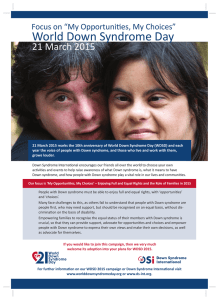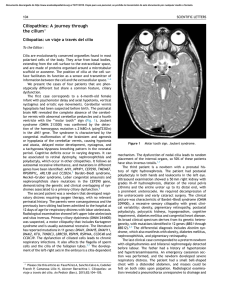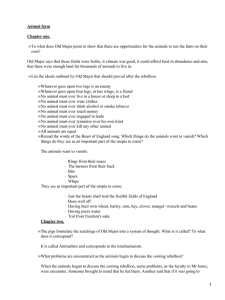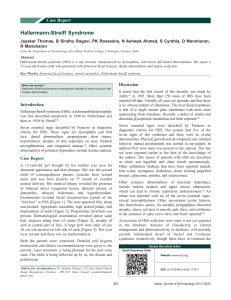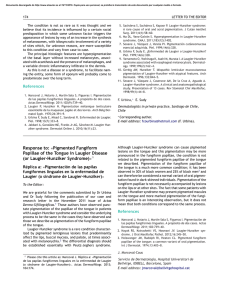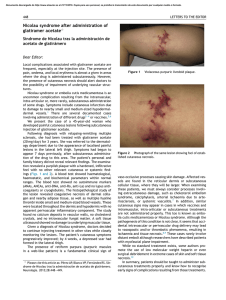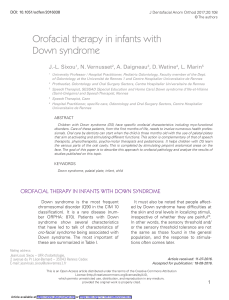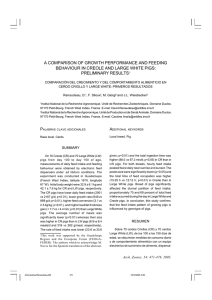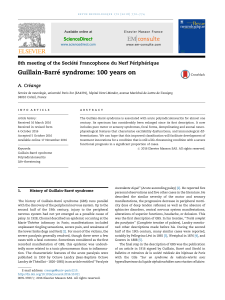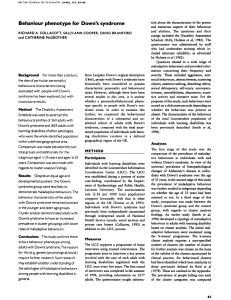humpy-backed» pigs` syndrome in spain
Anuncio
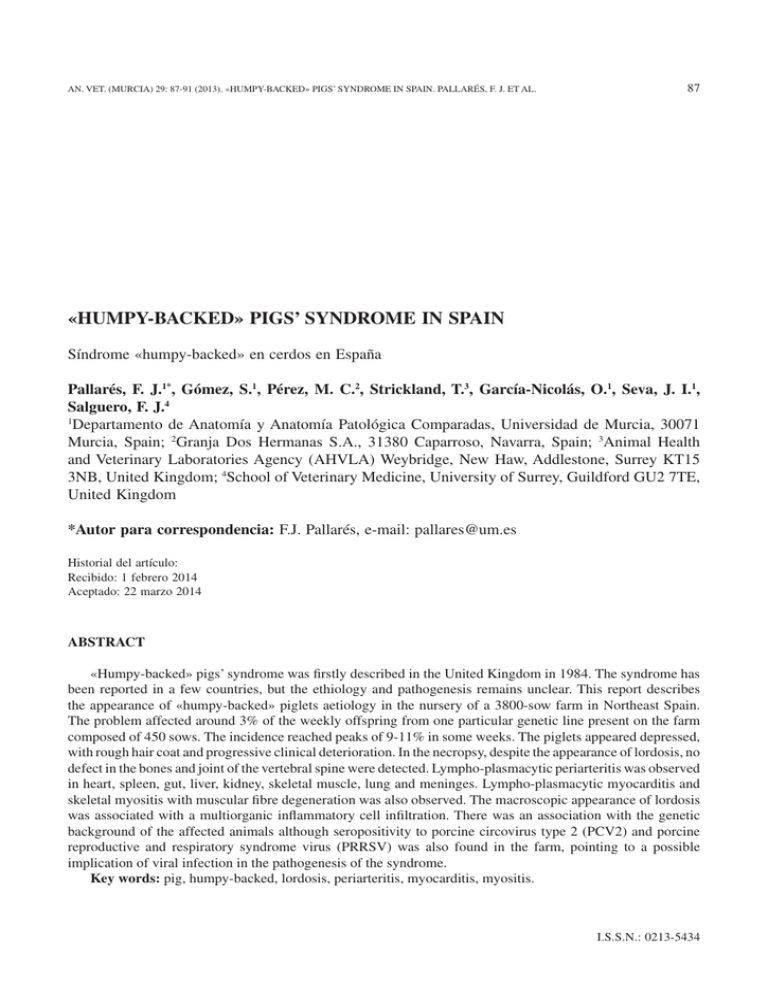
AN. VET. (MURCIA) 29: 87-91 (2013). «HUMPY-BACKED» PIGS’ SYNDROME IN SPAIN. PALLARÉS, F. J. ET AL. 87 «HUMPY-BACKED» PIGS’ SYNDROME IN SPAIN Síndrome «humpy-backed» en cerdos en España Pallarés, F. J.1*, Gómez, S.1, Pérez, M. C.2, Strickland, T.3, García-Nicolás, O.1, Seva, J. I.1, Salguero, F. J.4 1 Departamento de Anatomía y Anatomía Patológica Comparadas, Universidad de Murcia, 30071 Murcia, Spain; 2Granja Dos Hermanas S.A., 31380 Caparroso, Navarra, Spain; 3Animal Health and Veterinary Laboratories Agency (AHVLA) Weybridge, New Haw, Addlestone, Surrey KT15 3NB, United Kingdom; 4School of Veterinary Medicine, University of Surrey, Guildford GU2 7TE, United Kingdom *Autor para correspondencia: F.J. Pallarés, e-mail: [email protected] Historial del artículo: Recibido: 1 febrero 2014 Aceptado: 22 marzo 2014 ABSTRACT «Humpy-backed» pigs’ syndrome was firstly described in the United Kingdom in 1984. The syndrome has been reported in a few countries, but the ethiology and pathogenesis remains unclear. This report describes the appearance of «humpy-backed» piglets aetiology in the nursery of a 3800-sow farm in Northeast Spain. The problem affected around 3% of the weekly offspring from one particular genetic line present on the farm composed of 450 sows. The incidence reached peaks of 9-11% in some weeks. The piglets appeared depressed, with rough hair coat and progressive clinical deterioration. In the necropsy, despite the appearance of lordosis, no defect in the bones and joint of the vertebral spine were detected. Lympho-plasmacytic periarteritis was observed in heart, spleen, gut, liver, kidney, skeletal muscle, lung and meninges. Lympho-plasmacytic myocarditis and skeletal myositis with muscular fibre degeneration was also observed. The macroscopic appearance of lordosis was associated with a multiorganic inflammatory cell infiltration. There was an association with the genetic background of the affected animals although seropositivity to porcine circovirus type 2 (PCV2) and porcine reproductive and respiratory syndrome virus (PRRSV) was also found in the farm, pointing to a possible implication of viral infection in the pathogenesis of the syndrome. Key words: pig, humpy-backed, lordosis, periarteritis, myocarditis, myositis. I.S.S.N.: 0213-5434 88 AN. VET. (MURCIA) 29: 87-91 (2013). «HUMPY-BACKED» PIGS’ SYNDROME IN SPAIN. PALLARÉS, F. J. ET AL. RESUMEN El síndrome «humpy-backed» fue descrito en cerdos por primera vez en el Reino Unido en 1984. El síndrome ha sido observado en algunos países pero la etiología y la patogenia son todavía desconocidas. Este caso describe la aparición de cerdos con «humpy-backed» en la lechonera de una granja de 3.800 cerdas situada en el noreste de España. El problema afectó aproximadamente al 3% de la progenie semanal de una línea genética particular de la granja compuesta por 450 cerdas. La incidencia alcanzó picos del 9-11% en algunas semanas. Los lechones aparecían deprimidos, con pelaje hirsuto y deterioro físico progresivo. En la necropsia, a pesar de la apariencia de lordosis, no se detectaron alteraciones en los huesos y articulaciones de la columna vertebral. Microscópicamente se observó periarteritis linfoplasmocítica en corazón, bazo, intestino, hígado, riñón, músculo esquelético, pulmón y meninges. También se observó miocarditis y miositis linfoplasmocítica con degeneración de fibras musculares esqueléticas. La apariencia macroscópica de lordosis se relacionó con infiltrado celular inflamatorio multiorgánico. Se asoció a un problema de tipo genético de los animales afectados, aunque podría haber una posible implicación de circovirus porcino tipo 2 (PCV2) y el virus del síndrome reproductivo y respiratorio porcino (PRRS) en la patogenia del síndrome, debido a la seropositividad frente a los mismos detectada en la granja. Palabras clave: cerdo, humpy-backed, lordosis, periarteritis, myocarditis, miositis. INTRODUCTION The appearance of periweaning «humpybacked» pigs was first described by Penny et al. (1984) in UK porcine farms. The characterisation «in depth» of the syndrome was made by Clark (2005) in piglets from Canadian farms ranging from one to twelve weeks of age. These animals appeared depressed, presented lordosis and kyphosis and sometimes the ears where held low. Fractures and thick bone calluses were often seen in the ribs. Microscopically, a multiorganic lymphocytic and/or necrotising arteritis or periarteritis and lymphocytic skeletal myositis and myocarditis were described. The appearance of the syndrome has also been described concurrently with a problem of alopecia areata (Drolet et al., 2012). No porcine circovirus type 2 (PCV2) lesions or positive PCV2 immunohistochemistry (IHC) samples were found, but due to the history of PCV2 problems on the affected farms, a possible effect of PCV2 as consequence of an in utero virus infection was proposed as the aetiology of the disease (Clark, 2005; Straw et al., 2009). Endemic PRRS has also been associated with the prevalence of the vertebral spine problem (Straw et al., 2009). Other non- infectious possible causes would be primary vertebral lesions caused by physical or metabolic abnormalities, stress on the lumbar spine caused by painful musculo-skeletal conditions, and their genetic background (Penny et al., 1984; Straw et al., 2009). CASE DESCRIPTION The case presented here took place on a 3800 sow farm in Northeast Spain. The farm was seropositive for porcine reproductive and respiratory syndrome virus (PRRSV), PCV2 and Mycoplasma hyopneumoniae. The appearance of «humpy-backed» piglets (Fig. 1) was detected in the nursery affecting around 3% of the weekly offspring from one particular genetic line present on the farm (composed of 450 sows). The incidence reached peaks of 9-11% in some weeks. The piglets appeared depressed, with rough hair coat and progressive clinical deterioration. Three affected 5-weeksold piglets were sacrificed and a complete post-mortem examination was performed. Inguinal lymph nodes were enlarged and despite the appearance of lordosis, no defect in the bones and joint of the vertebral spine were detected. Microscopically, lympho-plasmacytic AN. VET. (MURCIA) 29: 87-91 (2013). «HUMPY-BACKED» PIGS’ SYNDROME IN SPAIN. PALLARÉS, F. J. ET AL. 89 Figure 1. Affected 5-weeks-old piglet with appearance of lordosis. Figure 2. Lympho-plasmacytic infiltrates surrounding an arteriole in the muscle. 400x perivascular infiltrate was observed in heart, spleen, gut, liver, kidney, skeletal muscle (Fig. 2), lung and meninges. The infiltrate invaded the adventitia of some arteries in the kidney, spleen and lung. Lympho-plasmacytic myocarditis and skeletal myositis (Fig. 3) with muscular fibre degeneration was also observed. The presence of PCV2 antigen was detected in inguinal lymph nodes in two of the three pigs and was Figure 3. Necrotising myositis with presence of inflammatory infiltrates within affected areas. 100x associated with mild lymphoid depletion. One of these two pigs was also positive for PRRSV by IHC in mononuclear cells from mild periportal inflammatory infiltrates in the liver. Mycoplasma hyopneumoniae was not detected by in situ hybridization in the lung of any of the animals. About five months after the appearance of the process, it disappeared as suddenly as it had appeared. 90 AN. VET. (MURCIA) 29: 87-91 (2013). «HUMPY-BACKED» PIGS’ SYNDROME IN SPAIN. PALLARÉS, F. J. ET AL. DISCUSSION PCV2 has been associated with this problem, probably as a result of in utero infection (Clark, 2005; Straw et al., 2009). The in utero infection of PCV2 is associated with reproductive failure and the replication of the virus takes place mainly in the heart of the infected foetuses (Madson and Opriessnig, 2011). The farm where the syndrome appeared was seropositive to this virus but reproductive failure was not detected and the presence of PCV2 antigen was not found in the heart, only in the inguinal lymph nodes of two of the three pigs showing mild lymphoid depletion but no characteristic lesions of PCV2 infection such as granulomatous lymphadenitis were detected in any of the animals. Arteritis and peri-arteritis have been found in pigs infected with PRRSV (Halbur et al., 1995b) and the presence of virus antigen has been detected in several organs of the infected animals as lung, heart or lymphoid tissues (Halbur et al., 1995a). In our case, the presence of PRRSV antigen was detected only in a few cells in the liver of one of the piglets and associated with mild lesions of non suppurative interstitial hepatitis. Others characteristic lesions associated with PRRSV infection such as interstitial pneumonia or lymphoid follicular hyperplasia and follicular necrosis were not found in any of the animals. Peri-arteritis has been also described in Göttingen minipigs diagnosed with thrombocytopenic purpura syndrome (Maratea et al., 2006) but associated degenerative changes in vessels have not been found in these animals. Lesions in bones or skeletal muscles and a certain genetic background have been included among the non-infectious causes of the vertebral spine problem (Penny et al., 1984; Straw et al., 2009). No lesions in bones or joints in the vertebral spine were found but the skeletal myositis with muscular fibre degeneration may have contributed to the appearance of the lordosis in the affected piglets. The affliction in only one of the genetic lines present on the farm at that time corroborates the possible genetic predisposition. The syndrome has also been described concurrently with the appearance of alopecia areata (Drolet et al., 2012), but in the affected pigs in this farm alopecia was not observed and no microscopic skin lesions were detected. The incidence found in the present case coincides with those found in other studies in different countries that varied between 2.5 % and 11.4% (Straw et al., 2009). Done and Gresham (1988) reported a low incidence of «humpbacked» pigs from summer months to December, which increased after that, as occurred in this case where the problem started in January and finished in May. However Penny et al. (1984) did not find any seasonal prevalence. To the knowledge of the authors, this is the first description of a case of «hump-backed» pigs syndrome in swine farms in Spain. Further studies are needed to fully characterise the syndrome. REFERENCES CLARK, T. 2005. Hump-back pigs. Animal Health Expositor 6: 2. DONE, S.H. & GRESHAM, A.C.J. 1988. Lordosis and kyphosis («humpy-back») in pigs. Pig J. 33: 134-141. DROLET, R., DENICOURT, M. & D´ALLAIRE, S. 2012. Alopecia areata and humpy-back syndrome in suckling piglets. Can. Vet. J. 53: 865-869. HALBUR, P.G., MILLER, L.D., PAUL, P.S., MENG, X.J., HUFFMAN, E.L. & ANDREWS, J.J. 1995a. Immunohistochemical identification of porcine reproductive and respiratory syndrome virus (PRRSV) antigen in the heart and lymphoid system of three-week-old colostrum-deprived pigs. Vet. Pathol. 32: 200-204. HALBUR, P.G., PAUL, P.S., FREY, M.L., LANDGRAF, J., EERNISSE, K., MENG, X.J., LUM, M.A., ANDREWS, J.J. & AN. VET. (MURCIA) 29: 87-91 (2013). «HUMPY-BACKED» PIGS’ SYNDROME IN SPAIN. PALLARÉS, F. J. ET AL. RATHJE, J.A. 1995b. Comparison of the pathogenicity of two US porcine reproductive and respiratory syndrome virus isolates with that of the Lelystad virus. Vet. Pathol 32, 648-660. MADSON, D.M. & OPRIESSNIG, T. 2011. Effect of porcine circovirus type 2 (PCV2) infection on reproduction: disease, vertical transmission, diagnostics and vaccination. Anim. Health Res. Rev. 12: 47-65. MARATEA, K.A., SNYDER, P.W. AND STEVENSON, G.W. 2006. Vascular lesions in 91 nine Göttingen minipigs with thrombocytopenic purpura syndrome. Vet. Pathol 43: 447-454. PENNY, R.H.C., WALTERS, J.R., GRAY, J. AND JENNINGS, D.S. 1984. A «Humpybacked» syndrome of pigs. Proceedings of the 8th International Pig Veterinary Society Congress. Gent, Belgium, p: 268. STRAW, B., BATES, R. & MAY, G. 2009. Anatomical abnormalities in a group of finishing pigs: prevalence and pig performance. J. Swine Health Prod. 17: 28-31.
